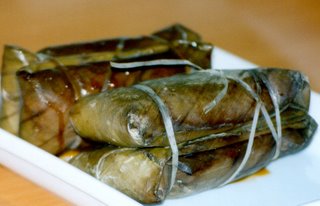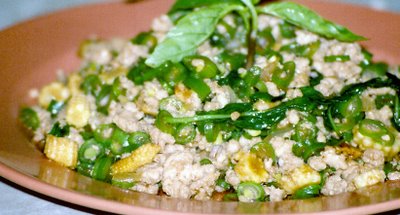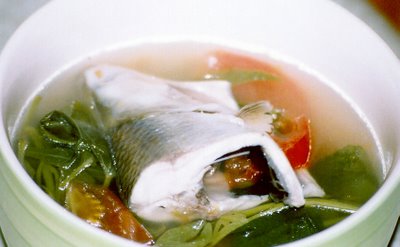Tuesday, July 18, 2006
On Temporary Hiatus
Thursday, May 25, 2006
Chicken Fillet with Mango
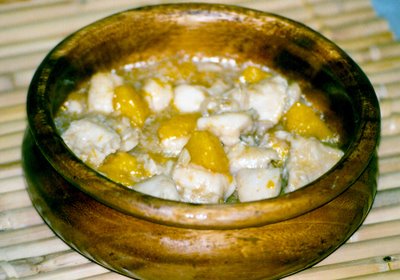 We held our wedding in Baguio City because at that time our hometown parish church was still under construction, having sustained irreparable damage from the powerful earthquake that shook Luzon and leveled down Baguio.
We held our wedding in Baguio City because at that time our hometown parish church was still under construction, having sustained irreparable damage from the powerful earthquake that shook Luzon and leveled down Baguio. Related Post
Pinkie's Fondant Cake
Other Chicken Posts
Pinaupong Manok sa Asin
Pinapuong Manok sa Sabaw
Pininyahang Manok
Adobo sa Mangga
French Baked Adobo
Chicken with Old Bay Seasoning
Chicken Mapo Tofu
Tinolang Native na Manok
Wednesday, May 24, 2006
Siriguelas
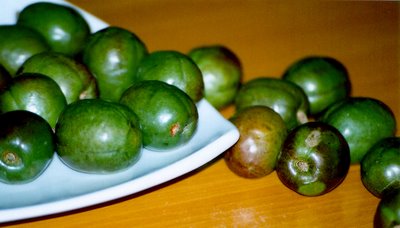 Siriguelas by the kariton-load have been going around residential and commercial areas for weeks now. There must be thousands of the small fruits per overflowing wooden cart, and several carts rove around throughout the day.
Siriguelas by the kariton-load have been going around residential and commercial areas for weeks now. There must be thousands of the small fruits per overflowing wooden cart, and several carts rove around throughout the day. This is one of the few local fruits I know which retain their names or a semblance of it all over the archipelago. Scientifically the term is Spondias dulcis Blanco, but the local names are saguelas/sarguelas (Ilokano), saraguelas (Ibanag), sereguelas (Bisaya), sineguelas/sirihuelas (Tagalog), siriguelas (Bikol/Pangasinan).
Siriguelas is not planted in my hometown, so we get to eat the fruit only when somebody goes out of town. It is a favorite pasalubong from the pilgrimage town of Manaoag, which produces the biggest and tarty-sweetest siriguelas in the province, sold in small, brown paper bags.
Tuesday, May 23, 2006
Lomboy
 Summer is heaving one of its last breaths, but before the rains come, we get a downpour of purple globules that stain the walkways and make birds and bats a-flutter.
Summer is heaving one of its last breaths, but before the rains come, we get a downpour of purple globules that stain the walkways and make birds and bats a-flutter.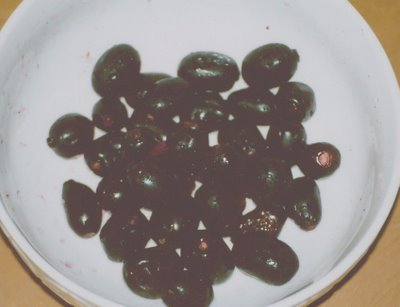
Related Post
The View from Below a Duhat Treet
Friday, May 19, 2006
Tinapay: Napoleones

This is part of an ongoing series, "Tinapay," about local breads found in street corner bakeries across the Philippines.

*Update: A commenter very kindly dropped a note in the comments section with the information that Roli's is actually available at the Building A of SM Megamall in Ortigas City. Thanks, C!
Roli's
St. La Salle Avenue (in front of St. La Salle Bacolod)
Bacolod City
Virgie's Products
59 San Sebastian Street, Bacolod City
The Tinapay Series
- Puto Seko (Laguna)
- Ensaymada
- Dealo Apas, Broas and Other Southern Tagalog Biscuits
(Lucban, Quezon) - Charito's Delights (Catbalogan, Samar)
- Half-Moon Cookie (Puerto Princesa, Palawan)
- Baker's Hill (Puerto Princesa, Palawan)
- Crema de Fruta
- Pedrito's/Jech (Dagupan City, Pangasinan)
- Panaderia de Molo (Iloilo City)
- Pastel (Camiguin)
- Inipit (Bulacan)
- Cinnamon Swirl Loaf (Baguio City)
- Kabukiran
Posts on the Food of Bacolod
Manokan Country
The Baye-Baye of Bacolod
Batchoy at 21
Cansi at Shopping
Reconnecting with Bacolod Sweets
Bacolod Products, Old & New
More Bacolod Products, Old & New
Lamud
Batwan
Wednesday, May 17, 2006
Ebeb
 This type of banana is relatively long and thick (longer and much fatter than the more common lacatan) and not fragrant. The skin is deep green, turning to light green when ripe. It has a subtle taste - you taste more of the flesh, with hints of sweetness here and a bit of sourness there.
This type of banana is relatively long and thick (longer and much fatter than the more common lacatan) and not fragrant. The skin is deep green, turning to light green when ripe. It has a subtle taste - you taste more of the flesh, with hints of sweetness here and a bit of sourness there.  It's called ebeb in Pangasinan, and I don't know what else in other languages, if it is eaten anywhere else at all. I doubt if this is what is called green bananas abroad, or just green bananas are what's called all kinds of bananas when still unripe.
It's called ebeb in Pangasinan, and I don't know what else in other languages, if it is eaten anywhere else at all. I doubt if this is what is called green bananas abroad, or just green bananas are what's called all kinds of bananas when still unripe.
It's not really very popular here in the Philippines - it's an exception to find it in the market these days. Probably because it is not as sweet as other varieties, and it doesn't travel and keep well.
I like subtleties, though, so I value it more than a banana assaulting all my senses with its unabashed sweetness. Pour a peanut-caramel sauce on it, and I'm a child again. Simply eaten on its own, one piece is very filling with its size. Now if only I can find it more often. I don't even know its season, and by the way it appears haphazardly, it may be close to being in no-season, for all time.
Monday, May 15, 2006
Lucban Miki
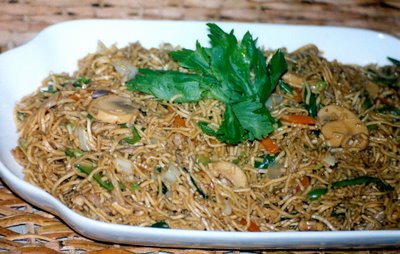 I have had the good fortune of developing a dear friendship with somebody starting on my freshman year in college. Her support meant so much to me when I ventured to join a university civic organization. She helped me survive, and she was one of the reasons I stayed on to many profitable and character-building years.
I have had the good fortune of developing a dear friendship with somebody starting on my freshman year in college. Her support meant so much to me when I ventured to join a university civic organization. She helped me survive, and she was one of the reasons I stayed on to many profitable and character-building years. 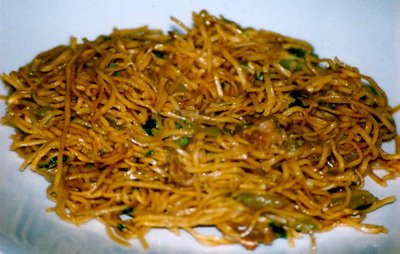 Pancit hab-hab is made from Lucban miki sauteéd with pork strips, native pechay, juliennes of sayote fruit and a little soy sauce. It is traditionally served on a small piece of banana leaf, requiring no utensils since it is eaten by bringing the container of noodles up to your mouth. Thus the term hab-hab.
Pancit hab-hab is made from Lucban miki sauteéd with pork strips, native pechay, juliennes of sayote fruit and a little soy sauce. It is traditionally served on a small piece of banana leaf, requiring no utensils since it is eaten by bringing the container of noodles up to your mouth. Thus the term hab-hab. Buddy's, a restaurant specializing in Quezon delicacies, has brought pancit hab-hab, among other things, to Metro Manila. Its noodle version is as authentically close as the one I ate in Lucban, including the spiced vinegar that is used to season the noodles instead of the usual calamansi.
But of course, it caters to Makati City patrons, and so it is a bit more affluent in terms of the ingredients than the one sold in the streets of its hometown.
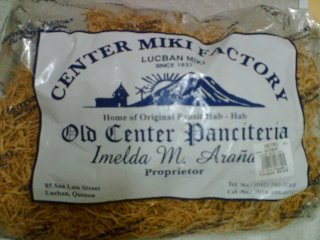 I have found out, though, that the key to having genuine pancit hab-hab is using the right noodles. In this case, it is the Lucban miki, which Center Miki Factory has been churning out since 1937. It is available in fresh and dried versions, and it is a very dense and flavorful egg noodle.
I have found out, though, that the key to having genuine pancit hab-hab is using the right noodles. In this case, it is the Lucban miki, which Center Miki Factory has been churning out since 1937. It is available in fresh and dried versions, and it is a very dense and flavorful egg noodle.
I discovered this on my last visit with my friend, who has since relocated to Lucena and is now a newly-minted lawyer. While waiting for my bus at the central terminal, I went around the stalls selling Quezon products. I espied this noodle pack, and did not need another second to consider in buying it. It was one of the most prized souvenirs I ever took home.
I generally dislike pancit canton because it becomes so greasy when sauteéed I get headaches from eating it. It also goes so wimpily limp and bland when overcooked or you mix in too much water.
Lucban miki is an exception. It holds its shape and structure after cooking, and is so tasty it needs minimal flavoring. That's why pancit hab-hab is simply cooked - the added ingredients just serve to enhance the noodles' flavor.
I have since located a stall at Tiendesitas selling Lucban miki (dried), as well as bought it (fresh and dried) once from the Gaisano supermarket at the Pacific Mall in Legaspi City on a weekend jaunt there. I still have to discover other vendors, so when I don't have access to these two I try substituting it with the Bicol pancit bato, which somehow comes a bit close.
I may come across as a pancit hab-hab fanatic. Well, I may be - I love all kinds of pancit. But I try to source out Lucban miki as often as I could because I have discovered another way of cooking it.
I've found out that it lends sooo well to stir-frying the Chinese way, or at least how the Chinese restaurants in the country do it. There is a particular stir-fried noodle I like served in the North Park noodle house chain, as well as those served in my favorite Chinese restaurant in Binondo, Kim Hiong.
Now, with Lucban miki, I am able to approximate these dishes. The Chinese flavor gives the Lucban miki a whole new dimension in taste and depth of flavor, as well as creating an entirely new eating experience.
I sauté it with pieces of fish fillet, chicken meat, squidballs, bell peppers, celery, carrots, and button mushrooms, adding ground pepper and oyster sauce when it is almost cooked. It is so good it will have you believe it was a Chinese noodle instead of being a true-blue Tagalog. Pork and beef slices also lend well to it.
Besides hardinera and pancit hab-hab there are other Quezon delicacies worth mentioning, such as the special tikoy and Dealo's apas. I have yet to find them in Metro Manila, so for the meantime I'll savor Lucban miki whenever I can find it.
Center Miki Factory
Lucban, Quezon
Buddy's
Makati City
8991170, 8957185, 8957980
Makati City
8995991, 8995993
(Open Air Food Court)
Market!Market! Mall
Fort Bonifacio, Taguig City
Related Posts
Quezon's Special Tikoy, Yema Cake, Pianono
Pahiyas 2011
Friday, May 12, 2006
The Politics of A Mango Harvest

This is the proper way to eat a ripe mango. Peel the skin with your hands from the pointed end, going around until only about a third is unskinned, then proceed to bite, from the top, holding the portion with skin still on.
Bite deeply, to the bony seed and around it, sucking on its fibrous fur. You're not doing it properly if the juices don't run down to your wrists and forearms. When you've uncovered half of the seed with your slurping, wet bites, transfer your hold to the end of the seed and peel the remaining skin.
Finish the fruit, taking care not to suck on the flatter end where the stalk was cut, or else you run the risk of developing swollen lips.



Wednesday, May 10, 2006
Apayas tan Agayep
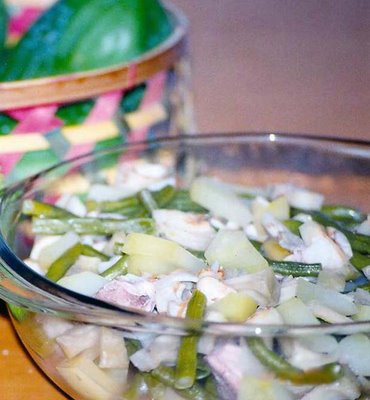

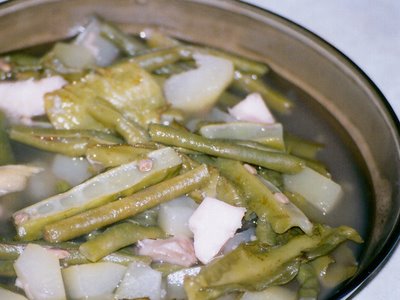 For variety, other vegetables can be added. Here we have bungá'y cabuéy, the fruit of that climbing vine which is considered a weed - called sigarillas in Tagalog (sigadillas, seguidillas, winged bean, Goa bean, asparagus bean).
For variety, other vegetables can be added. Here we have bungá'y cabuéy, the fruit of that climbing vine which is considered a weed - called sigarillas in Tagalog (sigadillas, seguidillas, winged bean, Goa bean, asparagus bean). 
Kamansī is another vegetable I crave for when I'm out of Pangasinan, but this post is already too long, so I will leave that for another time.
- Note: From the comments made on this post, may I add that this dish actually has a name in other places - dinengdeng or inabraw in the Ilocos and kibal in Batangas. Which got me into thinking that I should try finding out if there is a forgotten name in Pangasinan.
Friday, May 05, 2006
Do You Remember Choco Mallows?
 Those thick round chocolate rounds that melt into soft, gooey marshmallow and on to a chocolate cookie base? They were individually wrapped in silver foil and came in sixes in a thin, yellow rectangular box.
Those thick round chocolate rounds that melt into soft, gooey marshmallow and on to a chocolate cookie base? They were individually wrapped in silver foil and came in sixes in a thin, yellow rectangular box. But many people know that there is a thriving little black market for Choco Mallows, along with other cookies of the bygone, gentler years (remember Butter Crunch? Hi-Ro?). They come in unmarked cellophane packs, sold by ambulant vendors and enterprising individuals around the metropolis. These can be found even in Divisoria.
Monday, May 01, 2006
Inkalot A Bangos
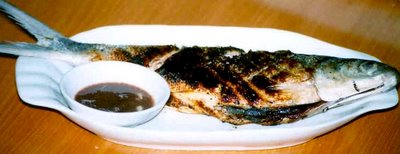
May 1 is observed across the globe as Labor Day. As the day falls on a Monday this year, it translates to a long weekend, as it is usually declared a special non-working holiday. An opportune time to schedule that long-postponed vacation trip.
*Commonly spelled bangus
Related Posts
Beach-Bumming
Sinigang na Bangus
Sinigang na Bangus sa Santol
Friday, April 28, 2006
Pinoy Summer Paella
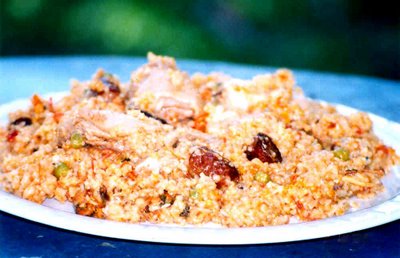 This is a very Pinoy (slang for Filipino) paella because, for one, it is not cooked in a paellera like the original Spanish paella - I cook it in a kaldero, which is where ordinary kanin or steamed rice is cooked. And it has a distinct tomato taste and color from the fresh summer tomatoes I stewed before mixing in, which is also why I identify it with summer.
This is a very Pinoy (slang for Filipino) paella because, for one, it is not cooked in a paellera like the original Spanish paella - I cook it in a kaldero, which is where ordinary kanin or steamed rice is cooked. And it has a distinct tomato taste and color from the fresh summer tomatoes I stewed before mixing in, which is also why I identify it with summer. - Sauté the tomatoes in a little oil and garlic and onions, and let stew for about an hour, or more if using the thick-skinned, native tomatoes. Blend in a food processor and set aside.
- Steam the mussels in water until they open. Take out the opened shells and set aside the soup.
- In about five tablespoons of olive oil, fry the chorizo until it renders fat. Remove, and fry for a few minutes on each side the chicken and pork, stir-frying the squid for about ten seconds, and set them all aside when done.
- In the same pan using the same oil stir fry and let the oil coat the washed rice. Mix in the chicken and pork and pour in the mussel soup and the tomato sauce, stirring to mix well.
- Transfer to a large kaldero and add about 2-3 cups of water (or more, depending on the age of the rice). Cover and let boil.
- When the sauce has been absorbed by the rice, mix in the mussels, squid, peas and bell pepper, lowering the fire until the rice is thoroughly cooked. Season to taste.
Thursday, April 27, 2006
Langka Cheesecake
Other cheesecake variants:
Black Forest Cheesecake
Mini Cream-O Cheesecake
Cream-O Cheesecakes
Wednesday, April 26, 2006
Phad Kee Mao
Monday, April 24, 2006
LP9: Inselar a Bangos
I dare say Filipino cuisine is indeed redolent with dishes containing lamang loob. This is related to Filipinos being very economical. Once an animal is slaughtered (for family consumption purposes, which happen during fiestas and family events), all parts and pieces are utilized, not a single part goes to waste.
So we have such Filipino mainstays as papaítan (thin slices of goat innards cooked in calamansi juice and bile), igadó (chopped pig intestines cooked in vinegar and soy sauce), bópis (minced pig lungs cooked in spiced vinegar), sísig (pan-fried chopped pig ears and chicken liver), dinakdákan (boiled and grilled pig ears and brain), even karé-karé (oxtail and tripe in peanut sauce and fermented shrimp fry) and adóbo of chicken liver and gizzard.
And we also have tomato stews with Spanish influences, like menúdo (pork meat and liver), callos (tripe), lengua (ox tongue). I've cooked some of these, ironically the Filipino ones I haven't, though I've watched countless washings of intestines in our backyard. Preparation and cooking are usually undertaken by male cooks, and I leave it at that. Especially since I fear buying innards in the market.
And so my contribution to LP9 is quite a common dish in Pangasinan, albeit probably unknown outside the province. It is siningang na bangós, with all the fish innards (except the gills and bile) thrown in the soup for flavor.
Bonuan bangós (milkfish coming from ponds cultivated in the coastal barrio of Bonuan in Dagupan City) has quite a legendary status in Pangasinan, and such worship is entirely deserving. No other bangós, whether cultivated in the province or elsewhere, tastes like it.
True to its name, the flesh is milky and sweetish, the fat in the belly inducing nirvana. There are less bones and those pesky thread-like spines, and there is never a fishy hint in taste. Like eating pure cream in the form of soft fish flesh.
Of course it follows that the innards of the bangós are as milky and as fresh-tasting as well. Pangasinenses and Ilocanos have a habit of flavoring soups (including tinóla) with bagóong (salted, fermented anchovies). In a sinigáng, the bangós innards take the place of the bagóong, and you have a very flavorful, quite tasty soup. Even insęlar a oráng (sinigang na hipon or shrimp in soured soup) uses bangós innards for flavor.
Restaurants along the beaches in Dagupan City cook sinigáng this way, particularly the famous Matutina chain of Pangasinan seafood casual dining.
To cook, fresh Bonuan bangós is sliced and put in a simmering pot of water flavored with a peeled ginger the size of your thumb, chopped tomatoes, sliced onions, salt and the innards, and calamansi juice (optional). When the fish flesh has turned opaque, add some kamote tops and continue cooking till the leaves are tender. Do not overcook so the fat will not disintegrate (very important!).
May I just add a note that it is critical to use fresh bangós, preferably newly harvested, and cook straight from the wet market. Never use previously frozen fish. If you only have access to the latter, it may be prudent to discard the innards.
Matutina's
- (Annex 1, 2, 3, 4)
Bonuan Blue Beach
Bonuan, Dagupan City- MacArthur Highway
Urdaneta City
Related Posts
- Bihod Sauté
- Bangus with santol & banana heart
- Silverio's Restaurant
- The ultimate way to enjoy bangus - grilled
Friday, April 21, 2006
Tinapay: Iloilo Delicacies By Way of Bacolod

This is part of a series, "Tinapay," on local breads from street corner bakeries across the Philippines.
Panaderia de Molo
San Jose Street, Molo, Iloilo City
Rizal Street, Iloilo City
The Tinapay Series
- Ensaymada
- Dealo Apas, Broas and Other Southern Tagalog Biscuits
(Lucban, Quezon) - Charito's Delights (Catbalogan, Samar)
- Half-Moon Cookie (Puerto Princesa, Palawan)
- Baker's Hill (Puerto Princesa, Palawan)
- Crema de Fruta
- Pedrito's/Jech (Dagupan City, Pangasinan)
- Napoleones (Bacolod City, Negros Occidental)
- Pastel (Camiguin)
- Inipit (Bulacan)
- Cinnamon Swirl Loaf (Baguio City)
- Kabukiran
Related Posts
Experiencing Iloilo in 24 Hours
Baye-baye
Public Market
Lunch: Nora's
Dinner: Breakthrough
Roberto's Siopao
Biscocho Haus/Wewyn's
Bacolod Pastries
Napoleones
Bongbong's/Roli's Napoleones
Casa Carmela Piaya/Quan Pandelitos/El Ideal Guapple Pie
Panuelitos/Clara's Barquillos
Thursday, April 20, 2006
Rediscovering Katíba
 Katíba is the Pangasinan term for what is commonly called coconut jam, or coco jam for short, elsewhere in the country. It is a common enough jam, made in many households across the Philippines, and manufactured and locally sold by at least two food processing companies whose only products are the jam and peanut butter.
Katíba is the Pangasinan term for what is commonly called coconut jam, or coco jam for short, elsewhere in the country. It is a common enough jam, made in many households across the Philippines, and manufactured and locally sold by at least two food processing companies whose only products are the jam and peanut butter. 
